I am a member of the Dutch association of wine connoisseurs (Verenigde Vinologen Nederland). As a member of the travel committee of the VVN, I organize wine trips to Italy together with Fred Nijhuis. This is the fourth day of our tour of Friuli. In the first three days we’ve visited Friuli Grave, Collio, and Brda.
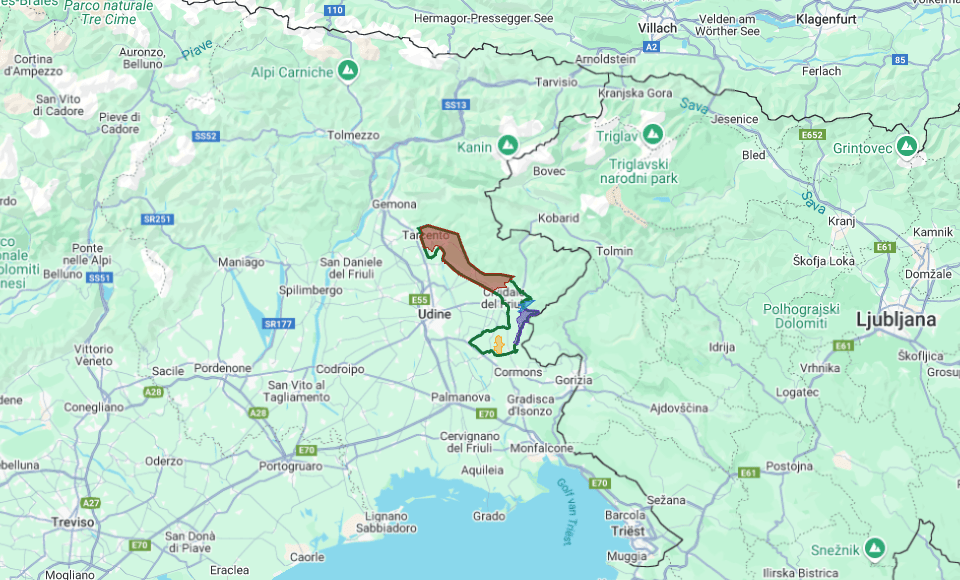
Friuli Colli Orientali DOC is to the north-west of Collio. The map shows the entire DOC, with subzones for Refosco di Faedis (red), Cialla (blue), Schioppettino di Prepotto (purple), and Ribolla Gialla e Pignolo di Rosazzo (yellow). The DOC includes three of the four DOCGs of Friuli: COF Picolit (all of the DOC), Ramandolo (in the north of the DOC), and Rosazzo (in the south, marked yellow on the map). Both Picolit and Ramandolo are for sweet wines from dried grapes; Picolit is also the name of the variety, and Ramandolo is made from Verduzzo. Rosazzo is for white blends. The DOC has about 2000 ha (5000 acres) of vineyards. About two thirds of the production is white, with as the main varieties Friulano, Pinot Grigio, Sauvignon Blanc, Ribolla Gialla, Chardonnay, Malvasia Istriana, Pinot Bianco, and Verduzzo. The main varieties for red wine are Merlot, Cabernet, Refosco dal Peduncolo Rosso, Schioppettino, and Pignolo. There are about 200 wine producers. Just like the other areas in Friuli, the Bora wind and draining soil are the main characteristics. 70% of the vines in FCO are 50 years or older, and a lot of the vineyards are in terraces (called ronco, plural ronchi, from Venetian).
Consorzio Tutela Vini Friuli Colli Orientali e Ramandolo
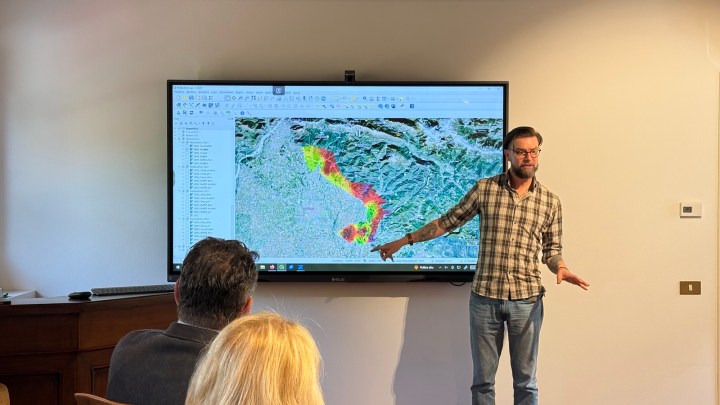
We started our exploration of FCO with a visit to the Tasting Academy of the Consorzio Tutela Vini Friuli Colli Orientali e Ramandolo. Matteo Bellotto gave us an interesting presentation about the amazing amount of data he has been collecting and analyzing together with his colleagues. This includes grape varieties, harvest volume, soil type, sugar and acidity levels of the grapes for each vintage, and much more. You can access this data by using the chatbot on the consorzio’s website or by downloading the book “Le Stagioni e le Uve” (Seasons and Grapes), which has been published annually since 2008.
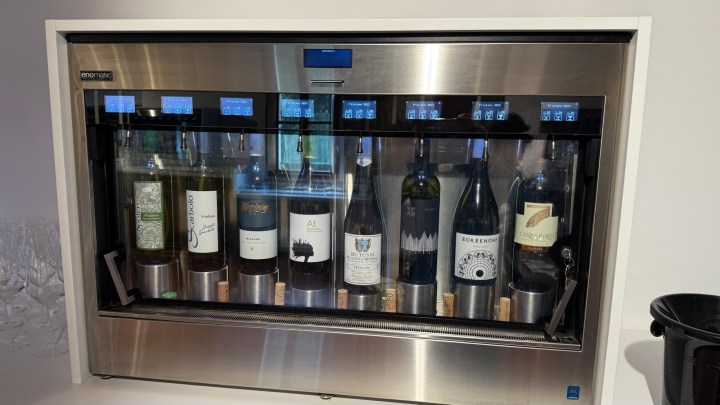
Of course we also tasted a lot of wines from FCO. There were machines around the room where we could select our own shot of wine…
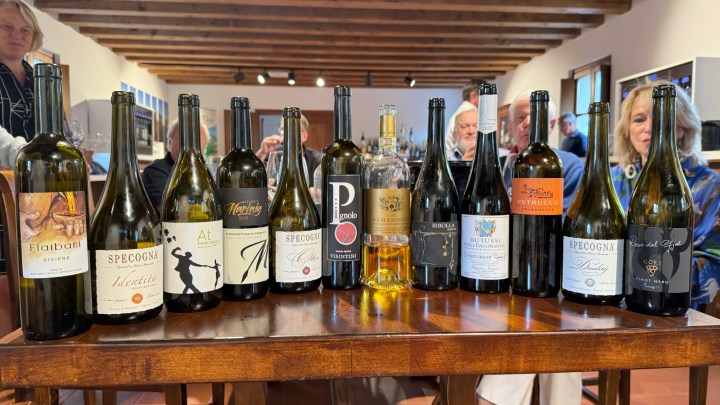
…but Matteo also opened 12 bottles for us:
- Flaibani Riviere FCO Friulano DOC 2022: mellow.
- Specogna Identita FCO Bianco DOC 2022 (field blend of 70% Friulano, 15% Ribolla Gialla, 15% Malvasia): salty.
- At Torre Bianco 2021 (50% Friulano, 50% Sauvignon Blanc): mineral, fresh, earthy.
- Marinig FCO Schioppettino di Prepotto DOC 2021: tannins quite present, but ripe.
- Speconga Oltre FCO Rosso 2021 (60% Refosco, 20% Pignolo, 20% Schioppettino): earthy, fresh, astringent tannins.
- Visinitini FCO Pignolo 2012: despite the age still a lot of tannin.
- Giovanni Dri Il Roncat Ramandolo DOCG 2022: sweet and fresh.
- Guerra Albano FCO Ribolla Gialla 2018: astringent.
- Butussi FCO Pinot Grigio Ramato (5-7 days skin contact): structured rosé.
- Petrucco FCO Chardonnay 2017: balanced, structure, creamy, fresh.
- Specogna Duality (Sauvignon Blanc): fresh.
- Gori Ronc dal Gial FCO Pinot Nero 2021: light, fresh, slightly astringent.
Solder
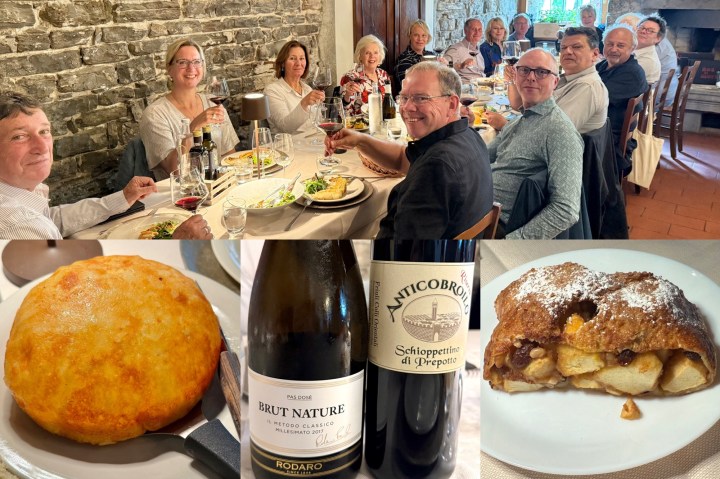
We had lunch at Agriturismo Solder. We had one of the most famous typical dishes of the area, a (pan)cake of potato and Montasio cheese called Frico (click here for my recipe) in a nice ‘blown’ shape, followed by typical dessert of the region: apple strudel (click here for my recipe). We enjoyed this with a Rodaro Brut Nature 2017 (classic method, 65% Pinot Noir, 35% Chardonnay, 68 months on the lees) and Anticobroilo FCO Schioppettino di Prepotto Riserva.
Gigante
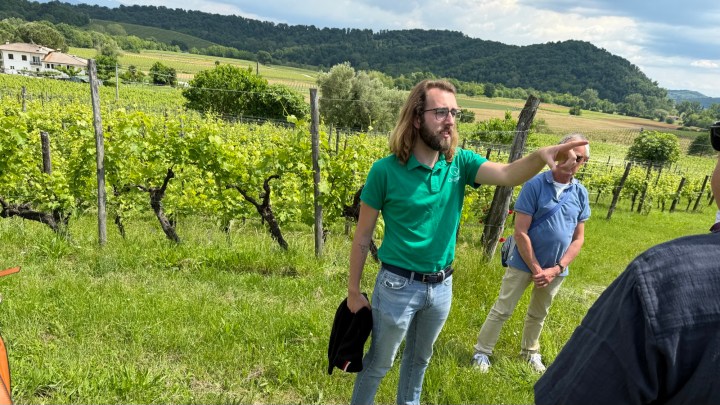
The first winery we visited in FCO was Gigante. Winemaker Alberto Pelizzo first showed us the vineyards. Gigante is a family business that was established in 1957. They now have 30 ha (75 acres) of vineyard. Their first vineyard, now 80 years old, has only Friulano. The yields are low, less than 1 kilo of grapes per vine. 50% of the production is in Friuli Colli Orientali DOC, the other 50% in Friuli Isonzo DOC. The soil is ponca. The vineyard is steep with a slope of 18%, with grass instead of terrraces to prevent erosion. The vineyards are certified organic. 70% is white and 50% is indigenous varieties. 60% is harvested by hand, 40% by machine.
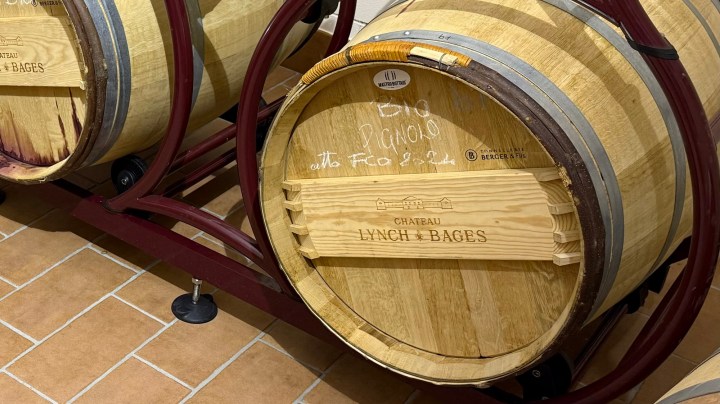
The Pignolo is aged for 3-4 years in second-hand barrels that have been used once for Château Lynch Bages (Bordeaux, France).

It was very nice that at Gigante we tasted not only the current vintage but also aged vintages:
- FCO Friulano DOC Vigneto Storico 2022 (from the historical vineyard with old vines, 12 hour skin maceration, then 10 months in steel with stirring of the lees): peach, white flowers, body, creamy, fresh, balance.
- FCO Friulano DOC Vigneto Storico 2002 (a cooler vintage, but quite old for a white wine): wonderfully aged, creamy, fresh, almond paste, beautiful. The entire (small) remaining stock of this wine was sold to members of our group after this tasting.
- FCO Sauvignon DOC 2023 (in two harvests, one at 12% potential alcohol and one at 13% potential alcohol, 24 hour cold maceration, 8 months in stainless steel with stirring of the lees): fresh, aromatic.
- FCO Sauvignon DOC 2015 (5 days cold maceration): developed, astringent from the skin contact.
- FCO Schioppettino Riserva DOC 2019 (3 years in 500 litre oak barrels, then 1 year in stainless steel): light, strawberry, peppery note (caused by rotundone, a compound that is higher in Schioppettino than other red grapes)
- FCO Schioppettino Riserva 2007: developed, but acids and tannins are still there.
- FCO Picolit DOCG 2015 (harvest mid november, 2 years in French oak barriques, 160 grams/litre residual sugar; they’ve stopped production of this wine as it is not economically viable due to the very low yields): golden, butterscotch, fresh, sweet, structure, perceptible hint of acetic character in the aroma.
Moschioni
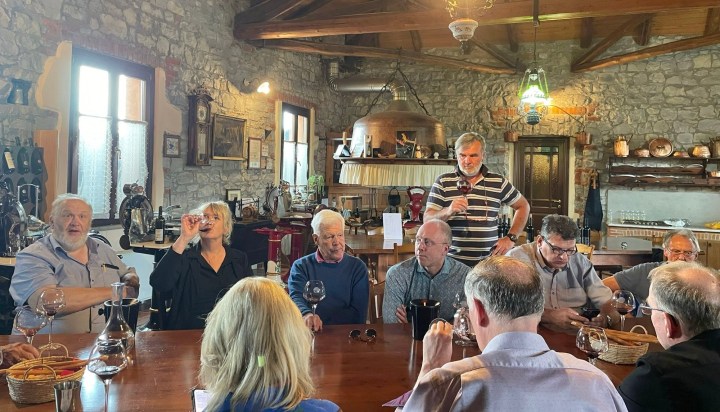
Our next visit was to Moschioni. We were received by Michele Moschioni himself, who has his very own style of winemaking (as well as very own style in general). In 1989 he made the choice to focus on red wines from autochthonous varieties, which was and is very unusual in this region dominated by whites. He is the 5th generation in the family business and believes that red wine is more tasty and more healthy than white. He has 13 hectares (32 acres) of vineyards, organic since 2009, certified since 2017. The grapes are all harvested by hand and brought to the cellar in boxes of 4 kilos in a single layer, so the grapes arrive safe and sound. For Schioppettino he uses untoasted oak barrels to preserve the elegance. All the wines get at least 5 years of oak, of which 1 year in barriques and the reminder in large barrels of Slavonian oak.
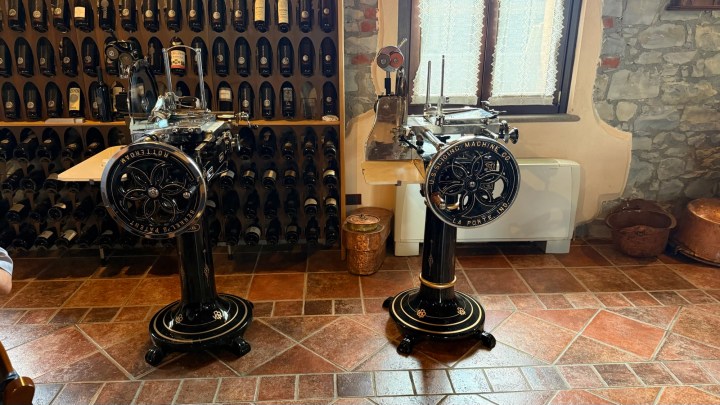
The choice for reds is not the only thing unusual about Moschioni. He also ages his wines for a long time before bringing them to the markt; the current vintages are 2016, 2015, and 2013. And he collects Berkel meat slicing machines.

After this introduction it was no surprise that the wines were special:
- FCO Bianco DOC 2022 (Friulano, made by Michele’s son Valentino who does not follow in his father’s footsteps and wanted to make a white, from old vines that were planted in 1970, partly on ungrafted vines, 4 days skin maceration, 2 years in large oak barrels): honey, peach, body, grippy, almond.
- FCO Refosco dal Peduncolo Rosso Riserva 2016 (1 year barrique, 4 years large barrel): tannin, acidity, developed aroma.
- FCO Rosso DOC Celtico 2015 (50% Cabernet Sauvignon, 50% Merlot, co-fermented): tannin, dark fruit, robust, powerful.
- FCO Rosso DOC Real 2015 (25% Merlot, 25% Cabernet Sauvignon, 50% Tazzelenghe (tongue-cutter)): fruity, tannin, acidity that does indeed cut your tongue a bit.
- FCO Rosso DOC Real 2006 (warm vintage): nice dark color, a bit less astringent than the 2015, still fruity.
- FCO Schioppettino Riserva DOC 2013 (grapes dried for 7-10 days, so like Amarone, Moschioni was the first to do this in Friuli): cherry, tannin, beautiful.
- FCO Pignolo Riserva DOC 2013 (old ungrafted vines, variety has become rare because of the low yield of only 12 hl/ha): very dark, powerful, tobacco, chocolate, 40 grams/litre of dry extract, 7000 mg/l phenolic content, which is much higher than other red wines. This wine needs another 4-5 years of bottle aging, and is difficult to pair because of its power.
Trattoria al Cacciatore
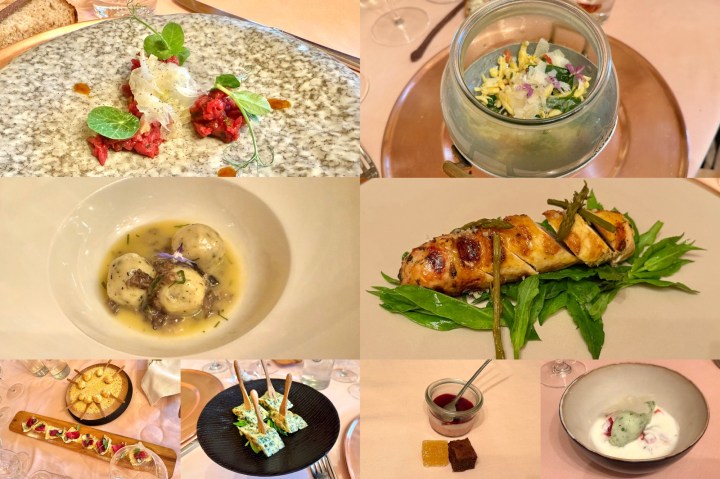
We had dinner at La Subida Trattoria al Cacciatore, with one Michelin star:
- Cured venison. Fennel salad and a sauce of sea buckthorn.
- Girini (crumbles of dropped pasta). The first sprouts from the flowered fields, rabbit and edible flowers
- Soft gnocchi filled with duck foiegras. Morels and wild garlic.
- Guinea fowl “Porchettata”. The breast rolled with pork and grilled, salad of ‘sclopit’ and ‘urticions’ in honey and vinegar.
- The Colourful Nest. White Chocolate, strawberries and poppy seeds.
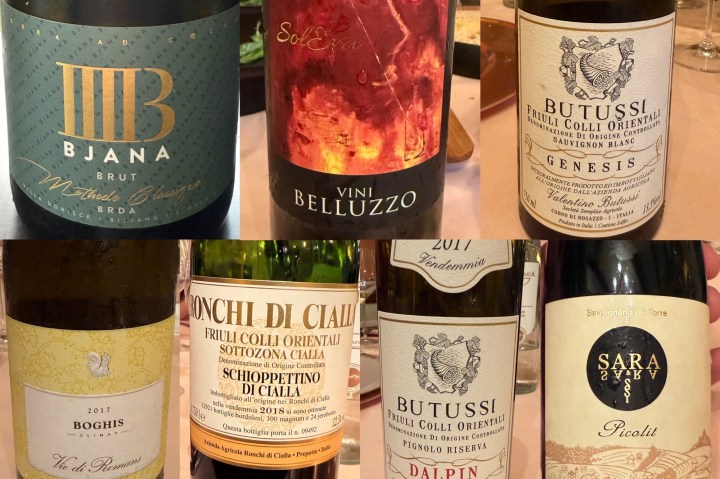
With this dinner we enjoyed these wines (two of which were sent to Butussi by the restaurant, because our tasting at Butussi had been cancelled last minute):
- Bjana Brut Brda Metodo Classico (Chardonnay and Pinot Noir, 10% in oak, 16-24 months on the lees)
- Vini Belluzzo Soleva Venezia Giulia Bianco IGT 2021 (100% Friulano)
- Butussi FCO Sauvignon Blanc DOC Genesis 2021
- Vie di Romans Bhogis 2017 (Chardonnay , aged 18 months in oak on the lees)
- Ronchi di Cialla FCO Schioppettino di Cialla DOC 2018
- Butussi FCO Pignolo Riserva DOC Dalpin 2017
- Sara & Sara FCO Picolit DOCG 2020


Thanks a million again for letting us learn even tho’ that may not include much of the tremendous wine knowledge . . . at least we get the idea. Thank you for the map . . . can see the road we always took to Austria thru’ Treviso . . . and have been to Villach and Klagenfurt and am not surprised about the apfel strudel 🙂 ! And, being pretty cluey about nutrition – Michele Moschioni is quite correct – red wines are way healthier than white and probably tastier. . . which does not change this white wone gal’s choices an iota 🙂 !!!
LikeLiked by 1 person